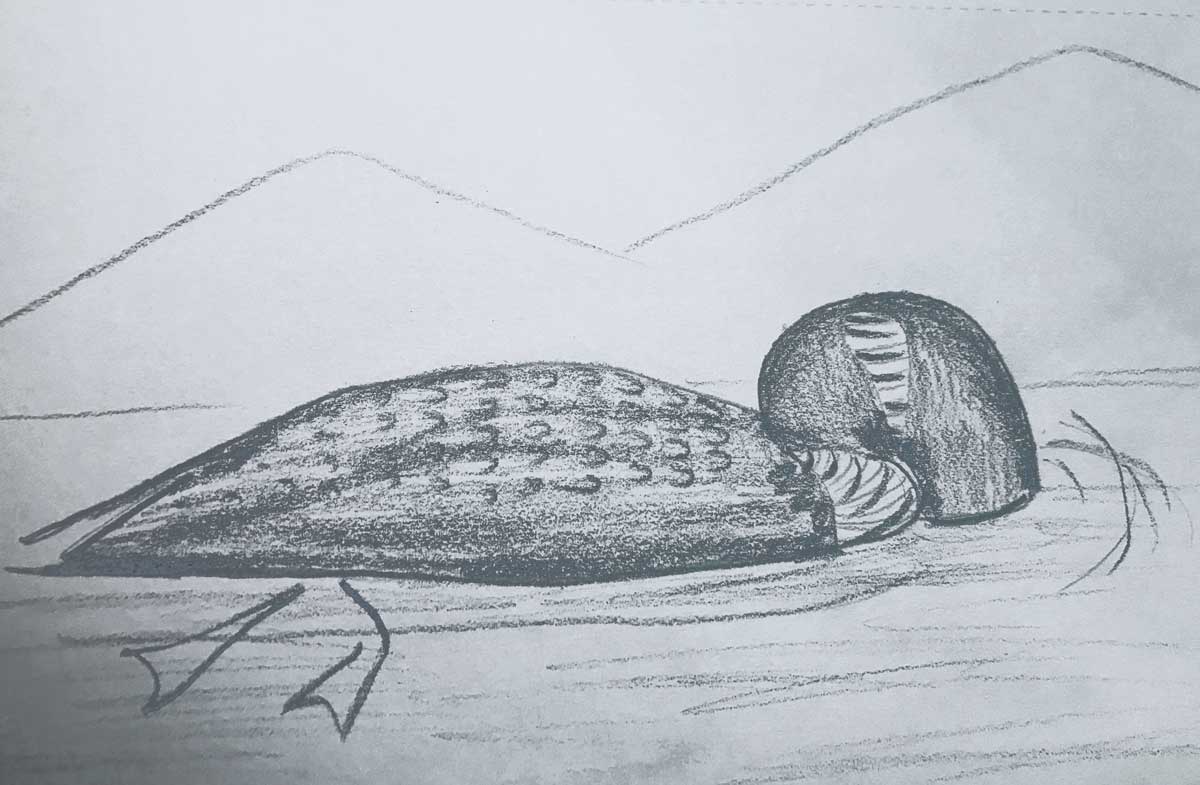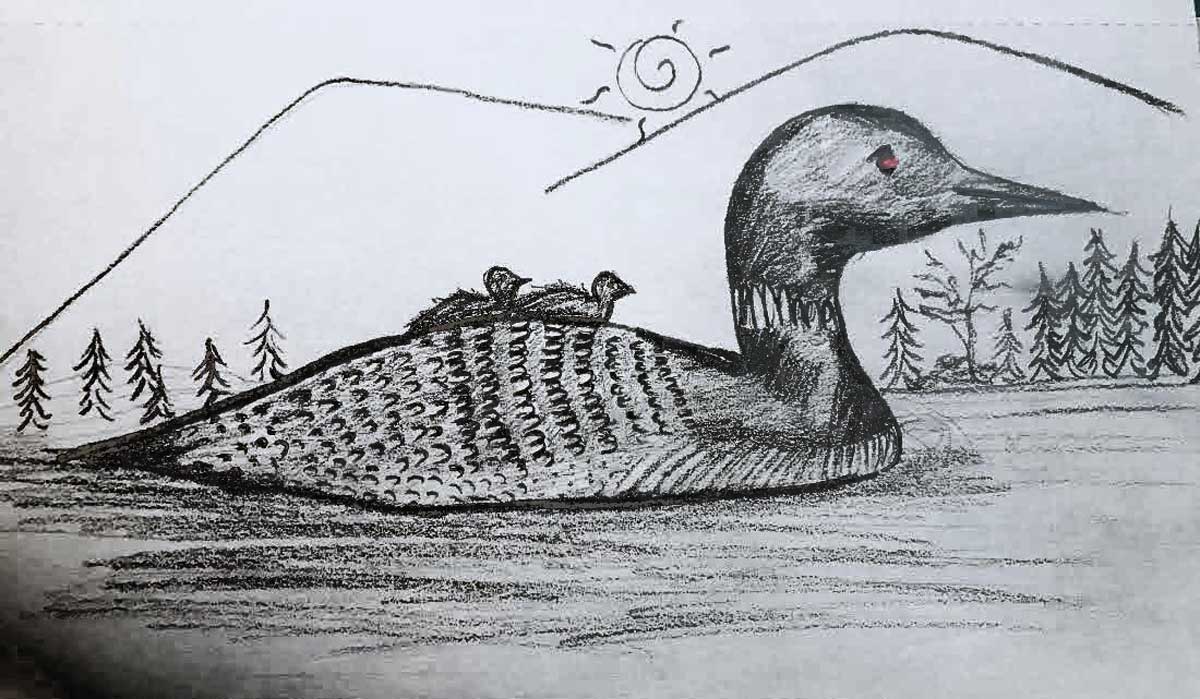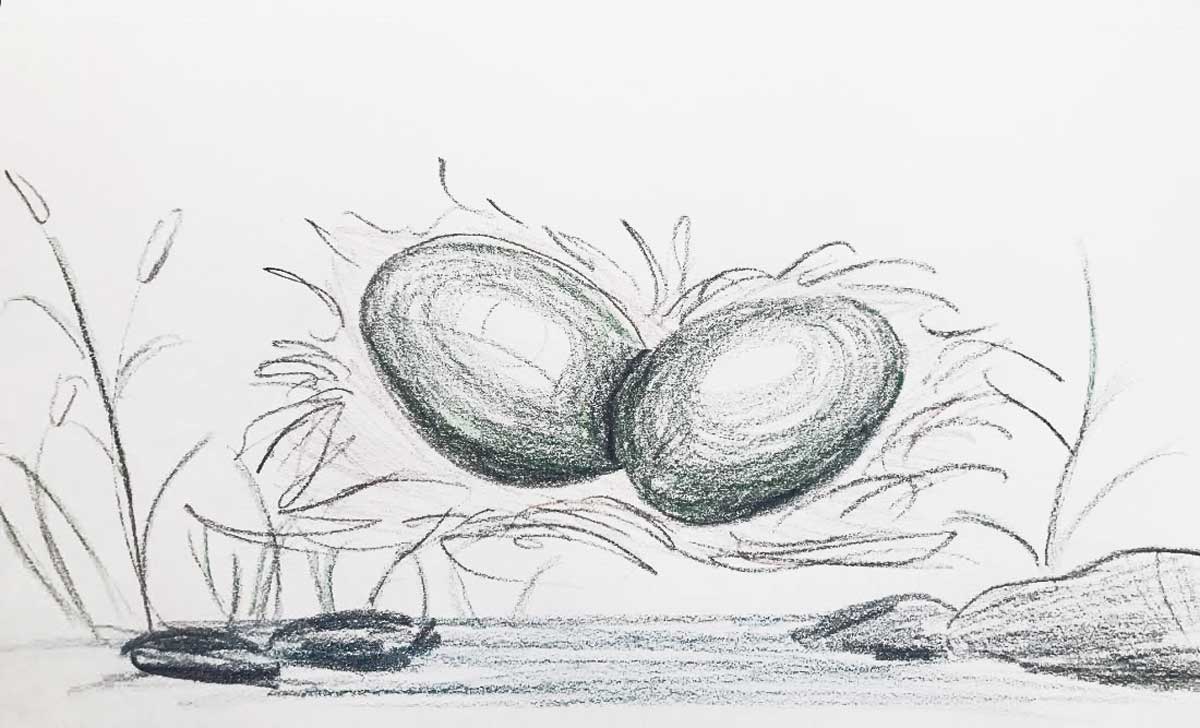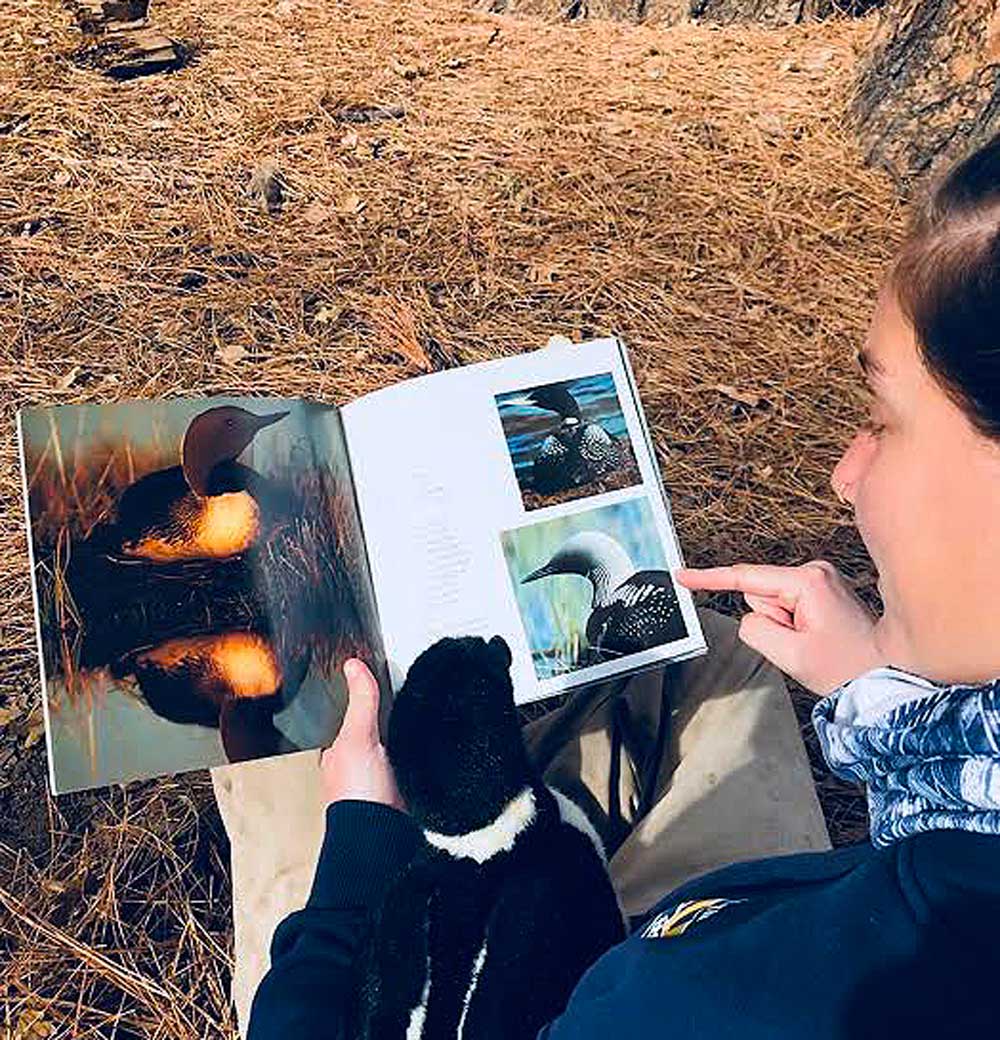There is a loonie legend about a small lake in rural Maine named Flying Pond.
As the story goes, the Native Americans of the region returned to the northern lakes every season for fishing and successful hunter-gathering. One particular year, they discovered a lake they had never found before, a lake that provided them the most successful season yet. They had decided to always return to this very lake. However, the following year, they could not find the lake. They searched and searched, but could never return to this beautiful place full of peace and prosperity. So, they believed it was the loons, with their strong wings and spiritual song, which lifted the lake with them and flew away.
 My childhood was spent by the clear cool waters of Flying Pond in Vienna, Maine. My days were spent searching for frogs in the creek, making fairy houses out of bark and moss, sailing and canoeing to all the islands. My nights, however, were spent gazing at the stars, listening and loving the eerie songs performed by the spirits of the water, the loons. I like loons, so perhaps I should share some information about them with you…
My childhood was spent by the clear cool waters of Flying Pond in Vienna, Maine. My days were spent searching for frogs in the creek, making fairy houses out of bark and moss, sailing and canoeing to all the islands. My nights, however, were spent gazing at the stars, listening and loving the eerie songs performed by the spirits of the water, the loons. I like loons, so perhaps I should share some information about them with you…

Xan is hanging with her loon, Luna, learning about her kind.
Characteristics and Adaptations
Named for their clumsiness on land, loons spend the grand majority of their life eating, sleeping, and exploring in the fresh waters of North America. They are long and thin, giving them graceful dexterity while fishing under water, holding their breath for up to ten minutes and up to two hundred feet deep! They have large webbed feet, set towards the back of their bodies to help propel them through the water like torpedoes, but this adaptation makes it very difficult and awkward to walk on land.
Additionally, their weight and body structure make it very difficult to take flight, so they have to flap their wings and frantically run across the water before they are airborne. They have long, elegantly pointed beaks for catching fish, and distinctive red eyes that help them see clearly underwater. Loons have elastic throats that allow them to swallow large prey whole; they can even swallow fish more than half their own size! They typically prey on perch and sunfish, but will also eat frogs, crayfish, and leeches.
Along with these characteristics, there are four different species of loons with a few subtle distinctions. The smallest of the four, the red-throated loon, usually weighs about four pounds and has darker, less distinctive plumage than the yellow-billed loon, the Pacific loon, and the Common loon, who all have white, doe-like speckles on their wings. The yellow-billed loon is by far the largest of the group, weighing in at an average of fourteen pounds! The Common loon weighs about ten pounds, and is typically the favorite of local lake loonies.
Vocal and Social Behavior
Loons’ vocal variations depend on circadian, seasonal, and weather patterns, in addition to specific social cues. We can determine the emotional, physical, and territorial state of a loon by the call they make. The “wail,” for instance, is a long-distance contact call between mates during territorial interactions. These are the sounds most often heard at night, the eerie, ghost-like call, when the acoustics are better and there’s a larger audience of territorial rivals. The “tremolo” is a short, laughing phrase, which sounds giddy and playful but actually indicates alarm and territoriality. The “yodel,” produced exclusively by males, is complex, frequency-modulated, and individually distinctive. It’s used for aggressive territoriality on breeding grounds and indicates male size, condition and motivation. Basically, the yodel means business. Finally, the “hoot” is a short, continuously quiet coo used around the nest between mother, father, and chicks. Lovely.
Listen to some great loon sounds here: https://www.allaboutbirds.org/guide/common_loon/sounds.
A study conducted on several lakes in Ontario, Canada provided some insight into the vocal behaviors of loons. According to the study, vocal output varied with time of day, year, and weather, with wails, yodels, and tremolos peaking in the middle of the night when transmission waves carried farther versus during the day. The study also indicated that hoots are mostly undetectable, as one would have to be very close to the nest to hear the soft cooing, and would thus endanger the emotional and physical safety of the subjects. Overall, it was discovered that wails, yodels, and tremolos vary seasonally, whereas hoots remained constant throughout the recording period. Additionally, wails, yodels, and tremolos decreased as breeding season progressed and the mates were remaining close by the nest. The conclusion of the research was that the nighttime transmission advantages paired with the high costs of physical disputes may be the driving evolutionary force for nocturnal signaling.
The “dances of the loon” are distinctive behaviors in which they either spread their wings proudly or wind up on their feet like a penguin and waddle around on the water. The former can either be in situations of territorial disputes or in mating rituals, whereas the latter is to ward off predators threatening the nest. Sometimes if a human gets too close to a nest, they become interested in this penguin territorial performance and are not wise enough to leave, and the protective loon will die of exhaustion. It’s very important and a mission dear to my heart to educate humans on the safety, privacy, and respect of the loons, and the negative impact humans can have on these beautiful creatures.
Loons are very active, involved, and committed partners and parents. In springtime, the mates make their nest together, usually in grassy hidden areas along lakes or on islands, and often reuse the same location year after year. Once one or two olive-brown, camouflaging eggs have been laid, the parents stay close to the nest to incubate and protect them from predators, which commonly include crows, ravens, gulls, skunks, and mink. However, the animal most responsible for lost loon eggs is the raccoon. If an egg is stolen, the parents spend the rest of the season vocally mourning the loss of their baby. The parents take turns incubating, protecting, and sharing the responsibilities that come with being an egg parent. They even flip the eggs over to even out the warmth. After one month, the eggs begin to hatch.
The little ones almost immediately jump in the water and join their parents, learning how to dive, fish and preen their feathers. However, baby loons will often ride on their parents’ backs to escape from the cold water and to protect themselves from underwater predators like snapping turtles and large fish. By autumn, the chicks will be fully grown and will fly to the southern coasts with their parents, only to return to the northern lakes in about three years to start loony families of their own.

Migration and Human Impact
The fresh lakes of North America freeze in the winter, and the loons find their way towards the salty coasts. The Common loon and Red-throated loon migrate to the Pacific and Atlantic coasts, with some even going as far south as the Gulf of Mexico. The Pacific loon, however, migrates exclusively to the Pacific coast, from Alaska all the way down to Baja, California. Although their wings are strong, take off and landing are no easy tasks, which makes migration a long and sometimes dangerous journey. There have been many reports of migrating loons mistaking wet roads and parking lots for bodies of water. In such cases, they are unable to take flight again and die.
In High Trails’ Feathered Friends class, we discuss the negative effects of harmful pesticides like DDT on bird reproduction and egg health. These birds include eagles, ospreys, and peregrine falcons. Loons are no exception, and their eggshells are about ten percent thinner than before the use of DDT. However, loons still seem to be reproducing successfully.

Loons are beautiful and fascinating birds, and while us loonies love to observe and appreciate them, it’s important to do so at a respectful distance and find avenues to help with habitat protection and public awareness. The loons have been gifting us with their song since the age of the dinosaurs, nearly 50 million years. As the oldest and most primitive living bird, they have substantial roles in much of Native American folklore and provide us with a wonderfully musical medium for studying birds, and a beautiful example to bring up in our Feathered Friends class with students.
Citations
- “Common Loon.” All About Birds. The Cornell Lab of Ornithology. Web. 24 Jan. 2015. <http://www.allaboutbirds.org/guide/common_loon/sounds>.
- “LOON FIGHT.” YouTube, YouTube, 7 Feb. 2009, <www.youtube.com/watch?v=VJ0IwpdwCVs>.
- Mennill, Daniel J. “Variation in the Vocal Behavior of Common Loons (Gavia Immer): Insights from Landscape-level Recordings.” BioOne Online Journal. 29 May 2013. Web. 24 Jan. 2015. <http://www.bioone.org/doi/full/10.1675/063.037.sp105>.
- “Loon Fight: Two males in a territorial battle.” YouTube, YouTube, 29 Oct. 2009, <www.youtube.com/watch?v=5HO1WQDwSRI>.
- Drawings drawn by the author.

At High Trails Outdoor Science School, we literally force our instructors to write about elementary outdoor education, teaching outside, learning outside, our dirty classroom (the forest…gosh), environmental science, outdoor science, and all other tree hugging student and kid loving things that keep us engaged, passionate, driven, loving our job, digging our life, and spreading the word to anyone whose attention we can hold for long enough to actually make it through reading this entire sentence. Whew…. www.dirtyclassroom.com

Comments are closed.